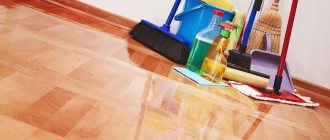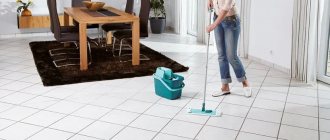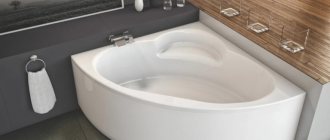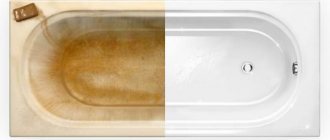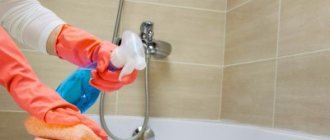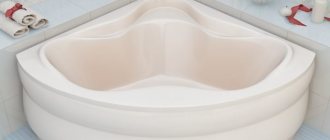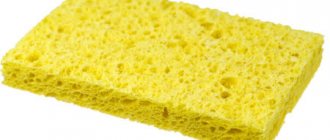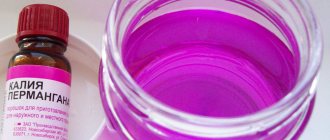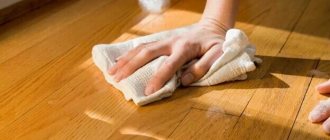As plumbing fixtures are used, their appearance deteriorates. This occurs due to soap deposits, dust, and other contaminants. To avoid having to use aggressive products to remove stubborn stains, it is recommended to ensure regular maintenance of your plumbing fixtures. First you need to decide how to clean the bathtub white at home, then study the instructions for use. This will prevent the coating from being destroyed.
Stubborn dirt in the bathroom.
How to clean different bathtubs
- Enameled cast iron baths. They should not be rubbed with steel wool or hard sponges. This leaves scratches and thins the enamel layer. Also, for cleaning you should not use aggressive products with a high chlorine content.
- Enameled steel baths. When washing, do not turn on too hot water. The enamel can crack even on a new bathtub due to sudden temperature changes. As in the case of a cast-iron bathtub, hard and metal sponges are prohibited.
- Acrylic baths. You need to wash it carefully, because even medium-hard sponges can leave unsightly streaks on such a bathtub. Use only soft sponges and special cleaning products, preferably gels or pastes. Do not use abrasive substances, washing powders, emulsions with alcohol, acetone, gasoline, or chlorine. A solution of soda and vinegar can be applied extremely rarely and only to particularly severe stains. In other cases, it is better to replace soda with lemon juice.
Causes and types of pollution
Reasons for the appearance of dirt and plaque:
- Soap residue - formed when using shower gels, shampoos, conditioners, etc. Simple rinsing is not enough here, since it is quite persistent and can only be washed off with cleaning agents and a brush.
- Limescale – occurs when water is too hard.
- Rust - comes from the water tap and settles on the walls of the bathtub, causing yellowing.
- Colored spots - their appearance is most often associated with inaccurate use of dyes, for example, hair dye, brilliant green, potassium permanganate, etc.
- When renovating an apartment, you should take care of the safety of the bathtub by covering it with film, because construction dust settles on it and is then difficult to wash off.
How to clean a bathtub from limescale
Hard water contains large amounts of magnesium and calcium salts. When they settle, a coating appears on the plumbing fixtures, which is more difficult to get rid of than soap.
Method 1. Vinegar-soda solution
- Mix ½ cup baking soda, ½ cup water and ¼ cup vinegar. If you are going to clean an acrylic bathtub, replace the baking soda with lemon juice.
- Apply the solution to the bath and leave for a while.
- Scrub the surface with a sponge and rinse off the vinegar solution with water.
Method 2. Soda + lemon solution
- Mix baking soda with water to form a paste.
- Apply to the bath and leave for a while.
- Add citric acid to water in a 1:1 ratio.
- Apply the solution to the baking soda and wipe with a sponge.
- Rinse the bathtub with water.
Removing other types of contaminants
Even if the product is used as intended, various nuances may arise during the work process. In addition, the type of pollution is taken into account. Some substances have a stronger effect on a number of materials and, conversely, are almost ineffective when trying to influence other compounds.
How to clean a bathtub from potassium permanganate and brilliant green
A combination of citric acid and hydrogen peroxide will help remove traces of potassium permanganate.
These substances strongly stain any surface. To remove traces of potassium permanganate, use a combination of citric acid (or fresh lemon juice) and hydrogen peroxide.
The brilliant green solution is cleaned from surfaces using alcohol. However, this option is ineffective in cases where an acrylic bowl is installed.
How to clean a bathtub after renovation
Citric acid helps get rid of the effects of dust. Contaminants are removed with water, then the walls of the bowl are treated. Paint can be removed with solvents, but first you need to do a test to check how such a substance will affect the bathtub coating.
How to remove sealant
First, remove most of the silicone. Residues are removed using salt-based products. Considering that abrasive is used, this option is not suitable for all types of plumbing fixtures. Special products from the chemical industry are more effective.
Methods for removing sealant in the bathroom.
How to clean an old bathtub
The best option is soda ash. This substance penetrates deep into the coating, fills microcracks, due to which the walls of the bowl brighten. You can use a method using baking soda, soda ash and bleach with vinegar.
How to clean a bathtub from rust
Rusty streaks in the bathtub are the result of bad pipes or damaged enamel. In this case, the best way to forget about the problem is to eliminate its cause. But there are also several home recipes.
Method 1. Ammonia + hydrogen peroxide
- Pour 100 ml of ammonia and 50 ml of hydrogen peroxide into a glass container. Mix well.
- Using a cloth, apply the solution to the problem area.
- Rinse off with water after 10–15 minutes.
Method 2. Lemon juice
- Squeeze some lemon juice onto the rust stain.
- Leave on for 10-15 minutes and rinse with water.
Method 3. Soda
- Add water to the baking soda until you get a paste-like consistency.
- Apply the resulting paste to the rust stains with a sponge.
- Rub and rinse with water.
Methods for cleaning different types of bathtubs
Depending on what kind of bathtub you have - acrylic, cast iron - the methods for washing it differ. So, it is better not to clean the first one with ordinary powder, but to use dishwashing detergent or liquid soap. To clean a cast iron bathtub, you will need a fairly soft sponge, as a hard one will leave scratches on the surface. The headache of any housewife is the yellow coating on the walls that appears as a result of daily contact with water, but it can be easily eliminated. First things first.
Acrylic
The surface of an acrylic bathtub will not withstand aggressive chemicals and, if regularly cleaned with them, will quickly become unusable. Therefore, you should avoid using products containing alcohol, ammonia and acids.
You should avoid washing such a bathtub with laundry detergent, otherwise it will fade and turn yellow.
Dishwashing detergent, liquid soap applied to a sponge is what you can use for cleaning. If you treat your bathtub with a special polish containing wax every 10 days, it will look beautiful for a long time.
Cast iron
Compared to an acrylic bathtub, it is more wear-resistant, but when cleaning it you should not use chlorine- or acid-containing products.
The sponge should also be soft enough; a hard brush will scratch the surface. After aggressive cleaning, it may turn yellow even more.
It is better to get rid of traces of rust as soon as they appear. To do this, you need to apply a little hydrochloric acid to the problem area and wash it off after 10-15 minutes. In this case, it is better to wear gloves on your hands.
Old cast iron bath
The main problem with such bathtubs is the formation of rust, limescale and coating with a layer of fat. But even in this case, there are many remedies that will help restore cleanliness:
- Whiteness - with its help you can return the white color and remove bacteria, fungi, mold, grease stains and rust. It is used only in diluted form: 1 part white and 2 parts water. The resulting liquid is applied with a sponge to the surface of the bath and left for 20 minutes. Do not neglect gloves when using white, as it irritates the skin. Another cleaning method: fill the bath with water and pour in about 100 ml of liquid, stir and leave overnight, drain in the morning.
- Mr. Muscle penetrates deep into stains and destroys them, helping to get rid of grease, dirt, lime and bacteria. Compared to whiteness, this product is more gentle on the surface, but also costs an order of magnitude more. It is also recommended to wear gloves when using it.
- Cif gel is effective for cleaning sinks and bathtubs. Easily copes with limescale and rust, returning shine to surfaces.
- Comet is available in powder and gel form. The latter cleans surfaces more gently compared to powder, which causes additional microcracks. The product helps eliminate not only all types of contaminants, but also microbes.
- Gel Sanox is the most effective among all the above products. It is used when other methods do not help. In addition to removing dirt, plaque and rust, it also destroys unpleasant odors. It should not be used often, only in emergency cases, as it “eats” the surface of the bathtub.
Ceramic
Cleaning ceramic baths has some features:
- should be regular, at least 2 times a month;
- you need to avoid hard brushes, powders and products containing abrasive particles, as they will lead to microscopic cracks into which dirt can easily get clogged, as well as to a decrease in the shine of the surface;
- The glaze used to cover a ceramic bathtub is acid-resistant, so you can safely use any liquid cleaning products and not be afraid of damaging the surface, but they should not be used more than once every 14 days.
Wooden
Wooden bathtubs are gaining popularity every day, because their quality is not inferior to others, they are environmentally friendly and have an unusual appearance. Caring for them is more difficult:
- It is necessary to wash the bathtub after each use in order to prevent the formation of ingrained, difficult-to-remove stains;
- use products suitable for varnished surfaces;
- It is worth periodically rubbing with special polishing and protective compounds.
Stone
Modern stone baths are extremely expensive. They come in 2 types: natural and artificial stone. The surface of the second type has no pores, corrosion is not terrible, so you don’t have to worry about the appearance of fungus and bacteria.
Care has its own characteristics:
- After each bath, rinse it with running water and wipe dry with a soft cloth;
- General cleaning needs to be done monthly. Moisten the bathtub from the inside and spray with a special non-abrasive detergent (for example, Delamark Royal Powder). It is worth making sure that it does not dry out, but remains moist throughout the cleaning process. After cleaning, rinse off any remaining product, wipe with a cloth, and polish with liquid wax.
Quarilovaya
This is a new type of polymer material. Quaril is a combination of quartz sand grains with acrylic capsules.
The main feature is resistance to mechanical damage - the material is not susceptible to scratches compared to acrylic. But the price of such baths is extremely high.
Operating rules:
- avoid extremely hot water;
- can be washed by any means, the material is not afraid of scratches and abrasives;
- due to the extremely smooth structure, it is enough to rinse the bathtub with water after each use;
- Do not place heavy objects near the bath; if they fall into it, they can damage the surface.
Marble
A marble bath is an extremely expensive pleasure, and it requires appropriate care:
- chemical cleaning products are prohibited;
- To remove contaminants, use a soap solution;
- light tones of marble are bleached using salt and lemon juice mixed to a paste-like consistency. The resulting mixture is applied in an even layer to the marble and left for 15-20 minutes, washed off with soap and water. If necessary, repeat the procedure;
- the washed and wiped bathtub is rubbed with polishing paste to add shine;
- In order to extend their service life, they are regularly sent for restoration, entrusting this matter to professionals.
How to use household chemicals
If you can’t get rid of dirt with home remedies, use cleaning powders and gels.
- Read the composition and consider the type of bath.
- It is better to use environmentally friendly substances, but they are more expensive.
- Follow the manufacturer's instructions. For example, sometimes the solution needs to be washed off immediately, sometimes it needs to be left for a while to make the bath clean.
- Some products have a strong, unpleasant odor. This means that to use them, your bathroom must have good ventilation.
- Never clean a bathtub without gloves.
Reasons why a bathtub becomes dirty
Before you start looking for a way to help clean your bathtub white, you need to understand the reasons for the appearance of streaks and other stains.
- Soap residue. The result of using various shampoos, bathing products and regular soap is the appearance of a film on the surface of the water in the bathroom. It is not always possible to remove it by simply rinsing. This film eats into the surface of the plumbing fixtures, and it is no longer possible to do without detergents.
- Limescale deposits form from water of high hardness. This is the most common bathroom problem.
- Rust is caused by tap water with a high iron content.
- If the bathtub has turned yellow, the reason for this is old pipes, which are not always washed well.
- Mold usually accumulates on tile joints between parts, on window slopes, and on the ceiling. This fungus is very dangerous to health, so it must be combated.
- Colored spots can result from careless handling of hair dye, spilled or spilled solution of potassium permanganate, brilliant green and other substances.
- Contamination from ongoing repairs. The bathtub is very susceptible to various stains and dust easily settles on it. Therefore, when carrying out repair work, it must be protected with film or other materials.
An old bathtub has cracks in its enamel, into which any dirt can easily penetrate.
Tips for caring for your bathtub surface
Everyone knows that the best care is prevention. To avoid the formation of difficult-to-remove stains, it is necessary to follow recommendations that will not only help maintain the dazzling whiteness of the surface for a long time, but will also simplify maintenance.
- Don't wait until the first signs of yellow or alkaline plaque appear, wash the bath after every shower. This will also remove soap scum, which accumulates very quickly. Rinse the surface with warm water to make it non-slippery, and then wipe it dry with a natural soft cloth;
- Drain the water completely and do not allow small wet islands to form. Their outlines will turn yellow very quickly. If the bathtub is installed at a slight angle and complete drainage is not possible, wipe off any remaining water with a cloth;
- Fix faucet leaks promptly. Do not allow water to drip onto the surface for a long time, this will lead to the formation of rusty streaks;
- Pay attention to the condition of the water pipes. Having replaced all the plumbing in the bathroom, it is reasonable to replace the hot and cold water risers and worn-out communication systems. Water flowing over the rusty inner surface of old metal pipes will carry with it particles of rust and turn a little yellow. When such water gets on the surface of a new bathtub, it will quickly acquire a yellow tint;
- Clean with various compounds once every two weeks, and disinfect once a week; Try to change the direction of the tap so that the flow of water does not constantly fall on the same place.
The article was written for the site.
Tags:Bathroom, Cleaning
How to clean acrylic with citric acid
Before you find out how to wash an acrylic bathtub, remember that the use of abrasives or powders is unacceptable. This form of cleaning products damages the product by scratching the polymer. Preparations such as Domestos, Silit, and Cif have proven themselves well in the household chemicals market.
Important! It is possible to wash a home bathtub made of acrylic with products containing a large amount of chlorine, such as Belizna, but this should be done carefully and in extreme cases. Chlorine is absorbed into the polymer pores and can cause yellowing of plumbing fixtures.
The procedure for cleaning an acrylic model using citric acid is as follows:
- Dissolve a tablespoon of lemon in a glass of hot water.
- Apply the soaked cloth to particularly contaminated areas. You can wipe the entire area of the bottom and walls.
- Rinse with warm water.
Important! It is acceptable to use the following types of household cleaning chemicals for plastic models: Ravak, Eago, Riton, Delfin.
How to eliminate sewer smell?
you get rid of unpleasant smell in the bathroom :
- check the operation of the ventilation, sewer system, pipe joints;
- improve ventilation draft;
- clean pipes and siphon from blockages;
- seal sewer joints.
Most often, the cause of the smell is a clog in the pipe, so first of all you need to focus your efforts on eliminating this problem. You can find out more here.
Special formulations
You can deal with dirt in the bathroom using store-bought products. Top 3 inexpensive and effective compositions:
- Chistin Professional gel for baths and showers. The composition is based on asurfactants and nonsurfactants, the formula is enhanced with citric acid and does not contain chlorine. The gel helps to cope with rust, lime and soap deposits, and unpleasant odors. Price – 90 rubles.
- Bagi foam for cleaning the bathroom Akrilan . This universal spray product is suitable for caring for different types of baths. The product effectively copes with rust, limescale and mold. One bottle is enough for 25 cleanings. Price – 435 rubles.
- GraSS bathroom spray Gloss . The liquid composition does not leave scratches and gives the bath its original shine. The spray effectively removes rust and lime deposits. There are no aggressive acids in the composition; the formula is based on citric acid and nonionic surfactants. The price of the bottle is 125 rubles.
An overview of the best bathroom cleaning products is presented in this article.
How to polish chrome parts to a shine?
There are several ways to clean the chrome parts in the bathroom to a shine:
Dishwashing liquid .
It is applied to a damp sponge, which is used to process all parts until foam forms. After 15 minutes, the surface of chrome products should be lightly rubbed with a cloth, rinsed with clean water and polished.- Vinegar . It will help cope with more persistent stains. In order not to spoil chrome, it is diluted with water in equal proportions. A sponge is moistened in the solution and rubbed onto all dirt. After 10 minutes, the composition is washed off with clean water.
- Store remedy. There are sprays and gels on sale designed to care for chrome surfaces. Their composition is designed in such a way that they remove stubborn dirt from chrome surfaces without harming the coating. For example:
- Aquanet spray (146 rubles),
- Vega spray (440 rubles),
- Rvak spray for plumbing fixtures Cleaner Chrom (525 rubles).
Washing the tiles
To clean bathroom tiles, you can use the following methods:
vinegar - it copes well with limescale;- laundry soap - it removes yellowness and has a whitening effect;
- soda ash - it dissolves well and does not leave scratches;
- store products - Mellerud liquid for tiles and stone (430 rubles), Help spray Clean bathroom (60 rubles), Cif anti-plaque bathroom spray (200 rubles), etc.
Compositions containing acid should not be applied to tile joints, as they can corrode the grout.
You can find out how to clean bathroom tiles here, and how to clean tile joints here.
What can't be used and why?
Mistakes to avoid when cleaning the bathroom:
- The use of metal-coated brushes is strictly prohibited. They will scratch the enamel. Dirt will begin to accumulate in these damages and rust will appear.
- You cannot apply acid to chrome parts, as they will darken and stains will appear on them that cannot be removed.
- Acrylic bathtubs cannot be treated with inorganic acids to avoid damaging their surface.
- Chlorine-containing compounds should be used with extreme caution. They are not recommended for use on acrylic and enamel bathtubs.
Cleaning of cement and primer
Before you clean tiles or plumbing fixtures from cement or primer, enlist the help of ATLAS SZOP. This chemistry will help you quickly cope with the task, but it is not recommended to use it when working with acid-resistant surfaces.
It will be much easier to remove the primer while it is still fresh. When working with the consistency, use acetone or a special remover. Vegetable oil will help you clean your bathroom until it shines and effectively remove cement dust. Add a few tablespoons of oil to a bucket of warm water and wipe the surface with a damp cloth.
How to clean silicone sealant?
To get rid of silicone sealant in the bathroom, you need to follow the following procedure:
- Moisten the sealant with water and wait 20 minutes.
- Using a spatula, scrape off the sealant with the sharp edge of the tool.
- Treat remaining sealant with gasoline or white spirit. Remove it with a wooden spatula.
To avoid damaging the bathroom surface during mechanical cleaning, you need to control the pressure force.
Find everything about cleaning the bathroom from silicone sealant here.
How to deal with mold and mildew
Using ordinary vinegar, you can wipe off mold from the joints between the tiles, as well as in the shower or on the side of the bathroom. While cleaning, soak a sponge in vinegar or use a spray bottle to treat the problem area. Wipe off any dried residue with a damp cloth.
Hydrogen peroxide or “Antifungal” will be a real salvation against fungus.
Pour peroxide into a spray bottle and spray onto the surface of the walls, sink and shower stall. During the washing process, do not forget to remove any remaining mold and mildew with a damp sponge. Don't scrub too hard on tile seams or dark plastics.
You can effectively clean your bathroom using professional products:
- Antiseptic "Dali". The solution can even be used when treating kitchens and wooden surfaces. Thanks to its safe composition, it will help effectively cope with the fungus.
- "Antifungal". Helps to forget about any manifestations of fungus and mold.
On the positive side, Cillit Bang and Clorox Tilex products have proven themselves. They do not damage the enamel.
Is it possible to clean it at home?
The degree of pollution varies. Cast iron bathtubs with damaged protective enamel are more likely to rust. It is worth determining what is in front of you: dirt or rusty deposits. Based on this, special or traditional cleaning methods are chosen.
The appearance can tell what happened to the enamel coating.
- Red stains indicate a high content of iron in tap water, old, rusty pipes, or chips.
- A white coating on the bathtub means that there are many impurities in the tap water; it is of low quality and contains calcium and magnesium.
- Yellowness over a large area - a lot of bleach and metal salts.
Cleaning cast iron bathtubs at home is possible. There is no guarantee that the tank will be washed to perfect condition; you can try to deal with stains and dirt.
